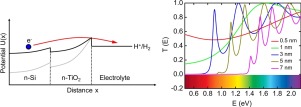当前位置:
X-MOL 学术
›
Appl. Catal. B Environ. Energy
›
论文详情
Our official English website, www.x-mol.net, welcomes your
feedback! (Note: you will need to create a separate account there.)
Rational design of Si/TiO2 heterojunction photocatalysts: transfer matrix method
Applied Catalysis B: Environment and Energy ( IF 20.2 ) Pub Date : 2017-09-01 , DOI: 10.1016/j.apcatb.2017.08.087 Xiaolong Yao , Lei Chen , Mengyin Liu , Deqiang Feng , Changhong Wang , Feng Lu , Weihua Wang , Xuewei Wang , Yahui Cheng , Hui Liu , Haijun Chen , Weichao Wang
Applied Catalysis B: Environment and Energy ( IF 20.2 ) Pub Date : 2017-09-01 , DOI: 10.1016/j.apcatb.2017.08.087 Xiaolong Yao , Lei Chen , Mengyin Liu , Deqiang Feng , Changhong Wang , Feng Lu , Weihua Wang , Xuewei Wang , Yahui Cheng , Hui Liu , Haijun Chen , Weichao Wang

|
The charge transfer in semiconductor heterojunction photocatalyst is one of the key factors determining its catalytic efficiency and durability in an aqueous environment. The widely used interface model with the simplified rectangular potential barrier fails to precisely predict the carrier transfer process since the band bending and its variation caused by solar energy are both not considered. Here, utilizing transfer matrix method, we take the Si/TiO2 heterojunction as a prototype to shed light on the rational design of the semiconductor heterojunction photocatalyst in terms of its intrinsic characteristics, such as TiO2 thickness and the dopant concentration. We find that the minimum incident energy (MIE) for electrons (holes) tunneling through the Si/TiO2 heterojunction decreases (increases) as the thickness of TiO2 layer increases. Within a moderate condition (TiO2 thickness of 3 nm and dopant concentration of 1 × 1018 cm−3 (5 × 1019 cm−3) in Si (TiO2)), both electrons and holes can transfer through the heterojunction barrier with relatively small incident energy. Furthermore, the photovoltage under illumination is beneficial for reducing MIE for electrons while increasing that for holes. Therefore, our transfer matrix scheme provides insights into rational design of the high efficient photocatalyst.
中文翻译:

Si / TiO 2异质结光催化剂的合理设计:转移矩阵法
半导体异质结光催化剂中的电荷转移是决定其在水性环境中的催化效率和耐久性的关键因素之一。广泛使用的具有简化的矩形势垒的界面模型无法精确预测载流子传输过程,因为未同时考虑由太阳能引起的频带弯曲及其变化。在本文中,我们采用转移矩阵法,以Si / TiO 2异质结为原型,就其固有特性(如TiO 2的厚度和掺杂剂的浓度)阐明了半导体异质结光催化剂的合理设计。我们发现,通过Si / TiO 2隧穿的电子(空穴)的最小入射能(MIE)随着TiO 2层厚度的增加,异质结减少(增加)。在中等条件下(TiO 2的厚度为3 nm,Si(TiO 2)中的掺杂剂浓度为1×10 18 cm -3(5×10 19 cm -3)),电子和空穴都可以通过异质结势垒转移相对较小的入射能量。此外,光照下的光电压有利于降低电子的MIE,同时提高电子的MIE。因此,我们的转移矩阵方案为高效光催化剂的合理设计提供了见识。
更新日期:2017-09-04
中文翻译:

Si / TiO 2异质结光催化剂的合理设计:转移矩阵法
半导体异质结光催化剂中的电荷转移是决定其在水性环境中的催化效率和耐久性的关键因素之一。广泛使用的具有简化的矩形势垒的界面模型无法精确预测载流子传输过程,因为未同时考虑由太阳能引起的频带弯曲及其变化。在本文中,我们采用转移矩阵法,以Si / TiO 2异质结为原型,就其固有特性(如TiO 2的厚度和掺杂剂的浓度)阐明了半导体异质结光催化剂的合理设计。我们发现,通过Si / TiO 2隧穿的电子(空穴)的最小入射能(MIE)随着TiO 2层厚度的增加,异质结减少(增加)。在中等条件下(TiO 2的厚度为3 nm,Si(TiO 2)中的掺杂剂浓度为1×10 18 cm -3(5×10 19 cm -3)),电子和空穴都可以通过异质结势垒转移相对较小的入射能量。此外,光照下的光电压有利于降低电子的MIE,同时提高电子的MIE。因此,我们的转移矩阵方案为高效光催化剂的合理设计提供了见识。











































 京公网安备 11010802027423号
京公网安备 11010802027423号